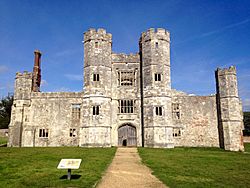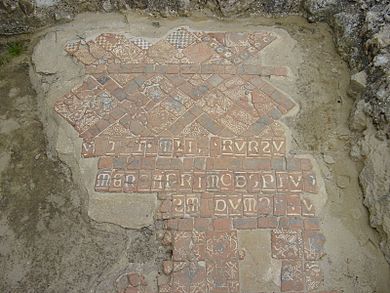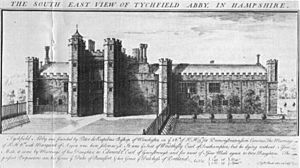Titchfield Abbey facts for kids

Titchfield Abbey in 2014
|
|
| Monastery information | |
|---|---|
| Full name | The Abbey Church of the Assumption of the Blessed Virgin, Titchfield |
| Other names | Place House (post-monastic period) |
| Order | Premonstratensian |
| Established | 1222 |
| Disestablished | 1537 |
| Mother house | Halesowen Abbey |
| Dedicated to | The Assumption of the Blessed Virgin |
| Diocese | Diocese of Winchester |
| People | |
| Founder(s) | Peter des Roches |
| Important associated figures | William Shakespeare, Henry VI, Margaret of Anjou, Charles I, Thomas Wriothesley, Henry Wriothesley |
| Site | |
| Location | Titchfield, Hampshire, United Kingdom |
| Visible remains | nave of church, ruins of east range, foundations and massive Tudor gatehouse of post-Dissolution mansion |
| Public access | yes, (English Heritage) |
Titchfield Abbey is an old abbey from the Middle Ages in England. It is located in the village of Titchfield, near Fareham in Hampshire. The abbey was started in 1222 for a special group of priests called Premonstratensian canons. These priests lived a very simple and strict life.
The abbey was not very rich or famous during its 300 years as a monastery. However, the people who lived there loved to study. They had a very impressive library filled with books.
In 1537, King Henry VIII closed the abbey. This was part of a big event called the Dissolution of the Monasteries. After it closed, a powerful person named Thomas Wriothesley turned the abbey into a large house. Later, in the 1500s, the house belonged to Henry Wriothesley. He was a supporter of the famous writer William Shakespeare.
The mansion was left empty and partly pulled down in 1781. In the early 1900s, the government bought the remains. Today, Titchfield Abbey is a protected historical site. It is looked after by English Heritage.
Contents
How Titchfield Abbey Was Started
The person who built Titchfield Abbey was Bishop Peter des Roches. He was a very important politician and church leader from Winchester. Bishop Peter started several religious places. These included Netley Abbey in Hampshire and Halesowen Abbey in Worcestershire.
In 1222, the first group of priests arrived at the new monastery. They came from Halesowen Abbey. These priests were not monks. They were called canons regular, part of the Premonstratensian order. People also called them 'white canons' because of their white robes. They were also known as Norbertines after their founder, St. Norbert.
These canons lived together and followed a very strict set of rules. They spent their lives studying and praying. But they also helped people in local churches. They served as parish priests, looking after the spiritual needs of ordinary people. This order was known for its simple way of life. This made them popular with rich people who wanted to donate money.
Bishop Peter was very wealthy. He was able to give a lot of land to his new abbey. He gave the manor of Titchfield itself. He also gave large areas of land across Hampshire. Other rich people and even King Henry III also gave gifts. King Henry III also gave the monastery special legal rights in 1231. This meant Titchfield Abbey was financially strong from the very beginning.
What Did the Abbey Buildings Look Like?
It was hard to find stone in Hampshire. So, the abbey was built using stone from other places. Stone came from nearby Dorset, the Isle of Wight, and even from Caen in France.
The main part of the abbey was its church. The church was quite small and not very grand. It was shaped like a cross. It had a narrow main area (nave) without side aisles. It also had a short eastern part and six small chapels in the arms of the cross (transepts). There was also a tower with bells. The design was quite old-fashioned and simple. This probably showed how strict the order was when it was built. The canons of Titchfield kept their original church until the end. They did not build a fancy new one like many other abbeys.
North of the church was a cloister. This was an open courtyard surrounded by covered walkways. Around the cloister were the abbey's other buildings. These included the chapter house (where meetings were held), the dormitory (where they slept), the kitchen, and the refectory (dining hall). There was also a library, food storage rooms, and the abbot's living area.
Even though the buildings were not huge, they were very well made. They had fine stone work and carvings. As time went on, the canons made their living areas more comfortable. By the mid-1300s, they were quite luxurious. You can still see fancy, colourful floor tiles today. These tiles were expensive and showed the abbey's high status.
The main abbey buildings were surrounded by a walled area. This area had gardens, fishponds (some still exist), orchards, barns, and guesthouses. There were also stables, a farmyard, and workshops. Several gatehouses controlled who could enter the abbey.
Life at the Abbey
Life inside Titchfield Abbey was usually peaceful. The abbey was well managed for most of its history. The canons had a good reputation for how they lived. Like other Premonstratensian houses, Titchfield Abbey was visited once a year. The head abbot from its parent house, Halesowen Abbey, would visit. Sometimes, a group from the main Premonstratensian headquarters in France would visit instead.
The abbey usually had enough money. However, like many other religious places, it faced big money problems in the late 1300s and early 1400s. This was because of the Black Death. This terrible plague caused huge economic and social problems. On the Titchfield lands, almost 60% of the people died in 1348-1349. Many animals also died. When the plague returned in 1361-1362, the farming population was hit hard again.
In 1420, an abbot from Halesowen Abbey visited Titchfield. He found the abbey's money boxes empty. The abbey was deeply in debt. Its barns were almost empty of food. But the canons managed to fix things. In its last years, Titchfield was doing well again. Inspections from 1478 to 1502 showed that Titchfield was very well run. Discipline was good, and its money was in order.
The abbey's location near Southampton and Portsmouth made it a good place to stop. Many important people stayed there on their journeys. King Richard II and Queen Anne stayed in 1393. King Henry V was a guest in 1415. He was on his way to Southampton to invade France. On April 23, 1445, a royal wedding took place at the abbey church. King Henry VI married Margaret of Anjou there.
The Abbey's Library

The Premonstratensian canons believed that studying was very important. The canons at Titchfield had a very impressive library. We even have a list of their books!
The library had 224 volumes. Each volume often contained several different works bound together. Some of these books must have been very large. The books were organized by subject and where they were kept in the library room. This room was probably between the chapter house and the church.
The books were in Latin, English, and French. They covered many topics. These included theology (the study of religion), church history, and writings by early Christian thinkers. There were also books on medicine, law, philosophy, and grammar. Some books were about travel, legends, and romances. The library also kept records of the abbey. The canons had another collection of over 100 books. These were used for church services and kept in the church.
A library of this size was huge for that time. It is surprising for a smaller abbey like Titchfield. For example, the great royal abbey of Reading Abbey had only 228 volumes.
Why the Abbey Was Closed
King Henry VIII closed the abbey in 1537. In 1535, the abbey's income was checked. It was found to be quite good, so it was not closed in the first round of abbey closures in 1536.
However, some important people at court wanted the abbey for themselves. One of these was Thomas Wriothesley. They put a lot of pressure on the abbot, John Salisbury, to give up the abbey. Abbot John tried to bribe Wriothesley to delay things. But when it was clear the abbey would be closed, he and his canons tried to save their own futures. They sold off the abbey's animals, treasures, and church items for money.
Titchfield Abbey finally closed in December 1537. Abbot John was a tough negotiator. He managed to get a good yearly payment for himself. He also got comfortable incomes for his eight canons and three novices. Abbot John remained in favour with the government. He later became the Dean of Norwich Cathedral and then a bishop. He died in 1573.
Place House: The Abbey Becomes a Mansion
Thomas Wriothesley succeeded in getting control of Titchfield Abbey. He immediately started turning it into a grand house for himself. He called it Place House. Just days after the canons left, officials sent Wriothesley a report. It described the state of his new property. They said the church was very bare. Most valuable items were gone. They also noted that converting the abbey into a house would cost about £200. However, paying the pensions to the canons and abbot would cost £120 each year.
The officials suggested that the eastern part of the church and the tower should be pulled down. Eleven days after the abbey closed, local people bought marble, altars, and sculptures from the church. The tiled floors were also taken up and sold. But only 10% of them were worth keeping. Even with things being sold off, the remaining stones were useful for the new house. Wriothesley also brought in new stone from Caen, France.
The officials were very impressed by the abbey's four fishponds. These ponds were very long and full of fish like carp, tench, bream, and pike. They estimated there were 100,000 fish!
Wriothesley decided to turn the main abbey buildings, including the church, into his home. This was a clever plan. A master builder named Thomas Bartewe led the work. He was known for building King Henry's forts along the coast. He built a spectacular gatehouse with four towers. This gatehouse was put right through the middle of the old church's nave. It made the house look like a grand, fortified home, typical of Tudor architecture.
The old cloister became the central courtyard of the house. A magnificent fountain was placed in the middle. The old dining hall (refectory) became the great hall. The rest of the abbey was turned into fine rooms for the family. The church tower was kept at first. But it was soon pulled down. An official advised this because chimneys would have to be built very high to avoid smoking up the tower. The mansion also had a private indoor theatre and a deer park.
The new palace was very impressive. In 1540, a historian named John Leland wrote about it. He said Wriothesley had built a "stately house" with a "goodly gate" and a fountain in the middle. Place House looked so much like a castle that it was considered a fortified house. Building such a house usually needed permission from the king. Wriothesley forgot to get this permission. He was pardoned for this in 1542.
As the home of an important noble, the mansion continued to host important guests. Wriothesley's son entertained King Edward VI and his sister Queen Elizabeth I. Under the fourth Earl, Titchfield hosted King Charles I twice. Once in 1625 with Queen Henrietta Maria. The second time was in 1647, when the king was hiding from his enemies. King Charles II visited the next owner in 1675.
From the Earls of Gainsborough, Titchfield passed to the Dukes of Beaufort. They lived at Place House until 1741. Then, the estate was sold to the Delme family. They lived there for another 40 years. In 1781, they decided to abandon the mansion. They deliberately pulled down much of it to create a romantic ruin. Local people took stones from the abbey to build their own homes. You can still see these stones in old houses in Titchfield village. For example, a large fireplace in The Bugle Hotel in Titchfield was saved from the ruins.
Titchfield Abbey Today
Even though much has been destroyed, a lot of the abbey and Place House still remain. In fact, pulling down Place House has shown more of the abbey than would otherwise be visible. The nave of the church still stands to its full height. Wriothesley's gatehouse is also still there. East of the gatehouse, you can see the faint outline of the former church. This includes the choir and transepts.
Parts of the cloister buildings also survive. You can see the entrance arches to the chapter house and library. In the abbey's grounds, the fishponds have been kept. People still use them for fishing. West of the abbey, outside the English Heritage site, there is a small part of another abbey building. We don't know what it was used for.
Large areas of the old medieval tile floors are still there today. One inscription was in front of the canons' dining hall. It was later covered and saved under the steps to Wriothesley's banqueting hall. Two other areas of tiling are north of the gatehouse. These were hidden under spiral staircases during Wriothesley's rebuilding. So, they were not torn out like the other tiles. In winter, English Heritage staff cover the tiles with sand. This protects them from cold weather damage.
The abbey has been used for concerts, including folk and blues festivals. It has also hosted open-air theatre. Today, English Heritage looks after Titchfield Abbey. It is open for the public to visit.
Images for kids









